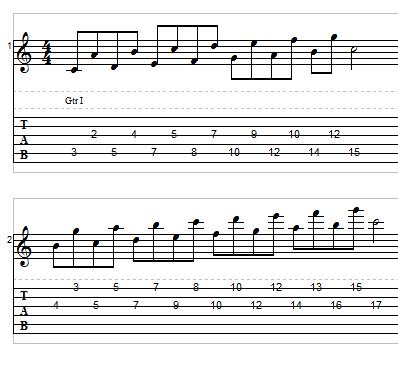I’ve been so busy getting the word
out about BOOGIE BLUES MAGIC that it’s been
a bit since I filmed a lesson
for y’all…
Well I have a cool one today.
It’s using a trick that’s used
all the time in blues guitar,
but I’ll show you how you can
use it in a new context, in melodic soloing.
While you’re on my blog, check
out all the cool sample videos
from Jonathon “Boogie” Long…
And if you haven’t seen THIS PAGE
yet, go here:
BOOGIE BLUES MAGIC
Thanks… Have an awesome weekend…
we are getting a lot of snow here in
Providence…brrrr…..
Stay warm… or cool… or whatever…
Hope you enjoy the lesson
And don’t forget to boogie!
Hey, guys. Claude Johnson from guitarcontrol.com and I’ve got another
mini lesson for you guys today. I hope you enjoy it. Let’s check it out.
Today we’re talking about 6th intervals and using them in your melodic
soloing. What we’re talking about here is stuff like this. It has a cool
sound to it. All we’re doing here is we’re basically using a 6th interval.
Let’s start with the key of C. The C major scale has all regular
notes, no sharps, no flats. What you do is you just count up six
notes. So start on the C, for example. Let’s count up six notes
on the scale. Let’s go to the next note; count up six. And you
keep going down. All you do is, again, pick any note of the scale
and just count up six notes. That’s kind of the theory behind it.
There are certain shapes and usually the shapes involve skipping a
string. There’s an exception to that. If you were, for example, using
like three notes a string, then you could get your 6th here. But
we’re not going to worry about that for now. Consider that all shapes
are just going to skip a string. Let’s go to our low E string, 8th fret.
Here’s your first interval, 8th fret and then 7th fret on the D string.
Again, and then. When we get to that 3rd note, the E, now we’re on
12th fret, 10th fret. So we’re gone back. This is a little bit of a
different interval. Technically you’d call it a minor 6th instead
of a major 6th interval, but the thing to know is you basically
just got two different shapes. This one and this one. If you want
to work it out for yourself you can, of course, check the tabs.
But basically all I’m doing is, again, counting up six notes.
You have the same shapes on the A string, but then when you get
to the D string it’s a little bit different. Here’s your C.
Here we don’t go back; we’re on the same fret. So it’s 10th
fret, 10th fret on the D and B string 10th fret, and then
here’s your minor 6th. You only go back one fret. And same
thing on the G string and the high E string.
What I want to talk about in this lesson is just the concept
of using these intervals to make your playing more interesting
as you’re soloing, like with the major scale. Now, I’m sure
you’ve all heard blues — used in a lot of blues, the
harmonization patterns. By the way, I go over a lot of
these harmonization patterns in “How to Play Smokin’
Blues Guitar”. So check that out; check that course out.
Also, another place in blues is like turnarounds. You’ve heard
this one a gazillion times. Basically I’m just kind of descending
chromatically here, but notice I’m using the 6th intervals.
The 6th intervals are very musical just by themselves.
One thing you can do is just slide around. Let’s take our C.
Go back to the key of C and you’ve got your C on your 3rd
fret A string. So you can just start going up the string,
up and back, your high E string. You can do it like that.
You can also kind of go back and forth like…
That’s kind of like more of a blues feel.
A really cool thing to do is kind of combine them so you
can just — sometimes you’re just going up, sometimes you’re
sliding like this. That’s pretty cool. You can use them as
you’re soloing. So if you’re playing more linear kind of…
You can kind of go into that 6th interval. So for example,
here’s a real simple lick. Or even simpler. See how that works?
A good fretboard exercise is you can just kind of noodle
randomly and then see, okay, where would the 6th be either
up or down? Like if you’re going up… So stop on that
note and then you can kind of go into your harmonization
from there. And then back into your linear playing.
You can also use it down or up. Just keep in mind, when
you’re playing with these you can go down the neck, up
the neck. You can play it like… Starting on the low one.
You can also play down like… And get all kinds of ideas.
Play around with it. Throw on a backing track, jam-out and
try to throw in those 6th intervals and you’ll be surprised
at all the kinds of cool things you can come up with.
Thanks for watching. I hope you enjoyed the lesson and I just
want to tell you about our brand new guitar course called
“Boogie Blues Magic”. It’s from Jonathan “Boogie” Long, winner
of the 2011 Guitar Center King of the Blues Contest. It’s a
3-DVD set with tabs showing you how to play in the 7 quintessential
chord blues styles. It’s awesome. So if you like blues guitar,
got to check it out. Just go to www.boogiebluesmagic.com.
So go there right now to check it out.
Thanks for watching and have an awesome day.




